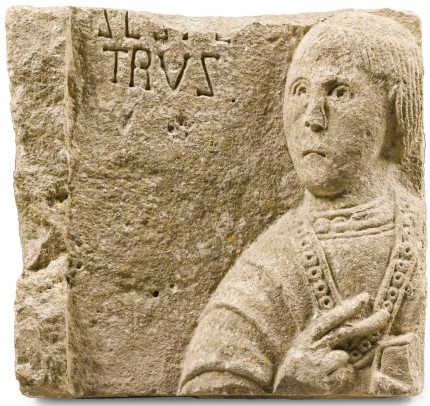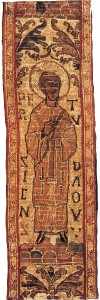
The Museum of Somerset in Taunton has acquired a medieval carving of Saint Peter that for years was used as a marker for a pet cat’s grave. The 18 by 17-inch stone is carved with the tonsured and clean-shaved saint with his head turned slightly to the right and two fingers of his right hand raised to his chest in benediction. A partial inscription on the top left — SC (S) (PE)TRVS — identifies the figure as Saint Peter.
The design is distinctly Anglo-Saxon, with a close parallel found in the figure of Peter the Deacon on the St. Cuthbert stole and maniple, a richly embroidered vestment made in Winchester between 906 and 916. It is a piece of a larger object, possibly a section of a shaft from a free-standing cross or larger relief panel that was later recycled as a building material. It’s made out of oolitic limestone, a stone that’s native to the south Somerset area where it was discovered. There are several religious institutions nearby that could have been the original source: Muchelney Abbey, a Benedictine monastery dedicated to Saints Peter and Paul, was just 10 miles away from Dowlish Wake, while Glastonbury Abbey is 25 miles away.
 Knowing the exact location where it was found might answer some of the questions about its original configuration, but it was only recognized as a rare surviving pre-Conquest carving after the stonemason, Johnny Beeston, who first rediscovered it had died. Beeston brought it home and installed it in his garden rockery in Dowlish Wake where it marked the grave of the dearly departed Winkles, a stray cat he had adopted. The person who recognized it was potter and local historian Chris Brewchorne who had a pottery shop across the road. It caught his eye in 2004. By then Johnny had joined Winkles over the rainbow bridge and Mrs. Beeston was willing to sell the piece.
Knowing the exact location where it was found might answer some of the questions about its original configuration, but it was only recognized as a rare surviving pre-Conquest carving after the stonemason, Johnny Beeston, who first rediscovered it had died. Beeston brought it home and installed it in his garden rockery in Dowlish Wake where it marked the grave of the dearly departed Winkles, a stray cat he had adopted. The person who recognized it was potter and local historian Chris Brewchorne who had a pottery shop across the road. It caught his eye in 2004. By then Johnny had joined Winkles over the rainbow bridge and Mrs. Beeston was willing to sell the piece.
They offered it to the Museum of Somerset for what would turn out to be a bargain price, but the museum didn’t have the funding at the time and declined the offer. So instead it was sold at a Sotheby’s auction in December of 2004 to Milwaukee native, timber and oil heir, art collector and all-around eccentric Stanley J. Seeger for £201,600 ($386,628).
Seeger died in 2011. His extensive collection of art was sold at auction, Sotheby’s again, in March of 2014 and the Peter stone sold for a far more modest £68,500 ($114,532) the second time around. That lower price was good news for the museum who could now arrange to buy it for £150,000 thanks to grants from the Heritage Lottery Fund (who chipped in the largest chunk at £78,600), Art Fund, the Arts Council England/V&A Purchase Grant Fund, the Fairfield Trust, the Friends of the Museum of Somerset and other donors.
The stone will go on public display in the Museum of Somerset, which occupies the great hall and inner ward of Taunton Castle, starting this Saturday, January 17th.